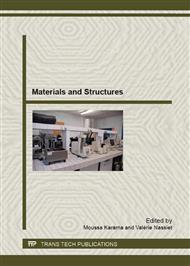p.73
p.85
p.97
p.105
p.113
p.119
p.127
p.135
p.143
Elastic and Elasto-Plastic Study for Bucket Tooth - Contribution to the Increase for Resistance of Collapse -
Abstract:
The bucket is a metal entity, linked to a machine called DRAGLINE, used for loading the different sizes of granular materials in large quantities. Each bucket is provided with six teeth which in contact with materials to be discharged, in order to extract the mineral. These teeth are connected to the bucket via a semi-rigid connection. In operation, except for the wear phenomenon "normal", some teeth break after a few hours of operation at the fixed portion in the singularity region (radius of curvature equal to zero). We observed via elastic numerical simulation in quasi-static regime, performed using PATRAN and NASTRAN software, that hot spots are located at the singularity region. We also used this numerical calculation for analyzing the effect of the variation radius of curvature on the stress concentration factor by plotting the variation of this factor vs of said radius. To deepen, we repeated the same study but this time considering the material of the tooth as elastic perfectly plastic for seeking the limit load. For each value of the radius of curvature, was plotted the variation of the elasto-plastic external force according to the displacement of the front end of the tooth, knowing that the other end is fixed.
Info:
Periodical:
Pages:
113-118
Citation:
Online since:
April 2013
Authors:
Price:
Сopyright:
© 2013 Trans Tech Publications Ltd. All Rights Reserved
Share:
Citation:


